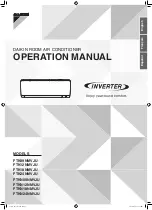
FORM 145.29-IOM2 (814)
JOHNSON CONTROLS
9
DUCTWORK
When installing ductwork, adhere to local Codes.
Minimize duct runs and avoid abrupt changes in
direction where possible. Allow ample access space
for servicing of the coils and changing of filters.
Perform regular maintenance on ducts to increase unit
life,
maintain
efficient
operation,
and
reduce
accumulation of explosive dust. Refer to blower
performance charts, and engineer duct runs and
accessory pressure drop so as not to exceed
maximum external static values. Ensure continuous
running condenser intake ambient air temperature do
not exceed 115
o
F. The condenser exhaust should
discharge into an open area to prevent short cycling of
hot exhaust condenser air with the condenser intake.
Louver sizing guidelines
One of the key issues in obtaining optimum
performance from indoor air-conditioners is the proper
selection of the condenser intake and discharge
louvers. Unlike outdoor air cooled units, which intake
and discharge their cooling virtually unrestricted,
indoor units must overcome the resistance of grilles or
louvers at the outside wall - plus the restriction of any
interconnecting ductwork.
Our indoor air cooled air-conditioners are designed to
accommodate the external static pressure loss
associated with properly sized louvers of the "storm
pro
of” type. This type of louver typically has a free
area approximately 40-45% of the actual louver size.
To determine the free area required for any given unit,
adhere to the following guidelines:
-
Size
condenser
air
intakes
for
350-600
feet/minute
nominal
velocity
(Maximum
recommended 700 feet/minute)
-
Size condenser air discharge for 1,200-1,500 feet
/minute nominal velocity (Maximum recommended
1,700 feet/minute)
The use of louvers with higher velocities than above
may be employed, at the discretion of the
engineer/installer, provided that the total air pressure
drop does not exceed the capability of the condenser
fan and motor. The use of low restriction louvers with
shallow blade angles can allow higher face velocities
without excessive static pressure loss.
Exceeding the static pressure capability of the
condenser fan will result in insufficient condenser air
volume. This will cause a loss in system capacity, and
may cause compressor shut-down during high
ambient
periods.
(Installation
of
an
oversize
condenser motor/drive, where applicable, may be
considered in such cases.)
(As a general rule, these velocities will require an
intake louver sized approximately 1.25 to 1.5 times
the dimensions of the duct connection on the unit, and
a discharge louver sized approximately 1.5 to 2 times
the duct connection dimensions.)
Use only louver sections that provide different
deflection angles for air discharge and air intake,
to ensure the unit does not short circuit
. Protect
the unit from weather conditions (rain, snow) entering
through the condenser air intake.
All outdoor air
ducts should pitch away from the unit, toward the
outside wall
. Connect all ducts to unit with canvas
section duct connectors or choose another suitable
noise and vibration absorbing device.
The Manufacturer will not accept any
liability resulting from incorrect instal-
lation of this equipment. Follow instal-
lation instructions carefully.
VARIABLE FREQUENCY DRIVE (VFD)
Optional VFD controller for the evaporator fan is
available on the 10 to 25 ton models. Mounted in the
in the evaporator module section, the VFD allows the
operator to set the duct static. The VFD will control the
frequency (speed) of the evaporator fan motor in order
to meet the desired supply duct static set point. For
reliable unit operation unit must have a factory
installed Hot Gas Bypass circuit on refrigeration circuit
# 1.
The unit does not carry a failsafe
circuit to bypass the VFD and run
the evaporator fan in the event of a
VFD malfunction.
VFD is factory mounted and wired. The installer must
field provide and install two sensor tubing lines
complete with static pressure probes. Installer is
required to field wire fan power wiring between
evaporator and condenser as a result of the unit being
shipped factory split. The power wiring can be found
inside the VFD enclosure, no extra power wiring is
required
– sufficient length is provided. The VFD
option does not include a evaporator fan bypass
circuit in case of microdrive failure. Microdrive will
need to be replaced to re-activate unit. In case of
VFD failure the evaporator fan will stop running
however unit compressors will continue to run until a
low pressure safety trip is activated.
Summary of Contents for DSV60B-300B
Page 5: ...FORM 145 29 IOM2 814 JOHNSON CONTROLS 5 DSV TYPICAL INSTALLATION DIAGRAM ...
Page 37: ...FORM 145 29 IOM2 814 JOHNSON CONTROLS 37 APPENDIX C TYPICAL UNIT WIRING SCHEMATICS ...
Page 38: ...FORM 145 29 IOM2 814 38 JOHNSON CONTROLS ...
Page 39: ...FORM 145 29 IOM2 814 JOHNSON CONTROLS 39 ...
Page 40: ...FORM 145 29 IOM2 814 40 JOHNSON CONTROLS ...
Page 41: ...FORM 145 29 IOM2 814 JOHNSON CONTROLS 41 ...
Page 42: ...FORM 145 29 IOM2 814 42 JOHNSON CONTROLS ...
Page 43: ...FORM 145 29 IOM2 814 JOHNSON CONTROLS 43 TYPICAL VFD UNIT WIRING SCHEMATIC ...
Page 45: ...FORM 145 29 IOM2 814 JOHNSON CONTROLS 45 NOTES ...










































